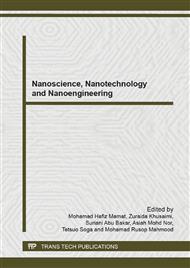[1]
P. Selvakumar, S. Suresh, Convective performance of CuO/water nanofluid in an electronic heat sink, Exper. Therm. Fluid Sci. 40 (2012) 57-63.
DOI: 10.1016/j.expthermflusci.2012.01.033
Google Scholar
[2]
S.U.S. Choi, Developments and applications of non-newtonian flows, ASME FED 231 (66) (1995) 99-103.
Google Scholar
[3]
C.T. Nguyen, G. Roy, C. Gauthier, N. Galanis, Heat transfer enhancement using Al2O3–water nanofluid for an electronic liquid cooling system, App. Therm. Eng. 27 (8–9) (2007) 1501-1506.
DOI: 10.1016/j.applthermaleng.2006.09.028
Google Scholar
[4]
X.L. Xie, W.Q. Tao, Y.L. He, Numerical study of turbulent heat transfer and pressure drop characteristics in a water-cooled minichannel heat sink, J. Electron. Pack., Transactions of the ASME 129 (2007) 247-255.
DOI: 10.1115/1.2753887
Google Scholar
[5]
M.R. Sohel, R. Saidur, M.F.M. Sabri, M. Kamalisarvestani, M.M. Elias, A. Ijam, Investigating the heat transfer performance and thermophysical properties of nanofluids in a circular micro-channel, Int. Commun. Heat Mass Trans. 42 (2013) 75-81.
DOI: 10.1016/j.icheatmasstransfer.2012.12.014
Google Scholar
[6]
C.J. Ho, L.C. Wei, Z.W. Li, An experimental investigation of forced convective cooling performance of a microchannel heat sink with Al2O3/water nanofluid, App. Therm. Eng. 30 (2010) 96-103.
DOI: 10.1016/j.applthermaleng.2009.07.003
Google Scholar
[7]
R.L. Hamilton, O.K. Crosser, Thermal Conductivity of Heterogeneous Two-Component Systems, Ind. Eng. Chem. Fund. 1(1962) 187-191.
DOI: 10.1021/i160003a005
Google Scholar
[8]
H. Brinkman, The viscosity of concentrated suspensions and solutions, J. Chem. Phys. 20 (1952) 571.
Google Scholar
[9]
B.C. Pak, Y.I. Cho, Hydrodynamic and heat transfer study of dispersed fluids with submicron metallic oxide particles, Exper. Heat Trans. 11 (1998) 151-170.
DOI: 10.1080/08916159808946559
Google Scholar
[10]
Y. Xuan, W. Roetzel, Conceptions for heat transfer correlation of nanofluids, Int. J. Heat Mass Trans. 43 (2000) 3701-3707.
DOI: 10.1016/s0017-9310(99)00369-5
Google Scholar
[11]
P. Kasten, S. Zimmermann, M.K. Tiwari, B. Michel, D. Poulikakos, Hot water cooled heat sinks for efficient data center cooling: towards electronic cooling with high exergetic utility, Fron. Heat Mass Trans. 1 (2010) 023006.
DOI: 10.5098/hmt.v1.2.3006
Google Scholar
[12]
X.F. Peng, G.P. Peterson, Convective heat transfer and flow friction for water flow in microchannel structures, Int. J. Heat Mass Trans. 39 (1996) 2599-2608.
DOI: 10.1016/0017-9310(95)00327-4
Google Scholar
[13]
T.-C. Hung, W.-M. Yan, W.-P. Li, Analysis of heat transfer characteristics of double-layered microchannel heat sink, Int. J. Heat Mass Trans. 55 (2012) 3090-3099.
DOI: 10.1016/j.ijheatmasstransfer.2012.02.038
Google Scholar
[14]
X.L. Xie, Z.J. Liu, Y.L. He, W.Q. Tao, Numerical study of laminar heat transfer and pressure drop characteristics in a water-cooled minichannel heat sink, App. Therm. Eng. 29 (2009) 64-74.
DOI: 10.1016/j.applthermaleng.2008.02.002
Google Scholar


